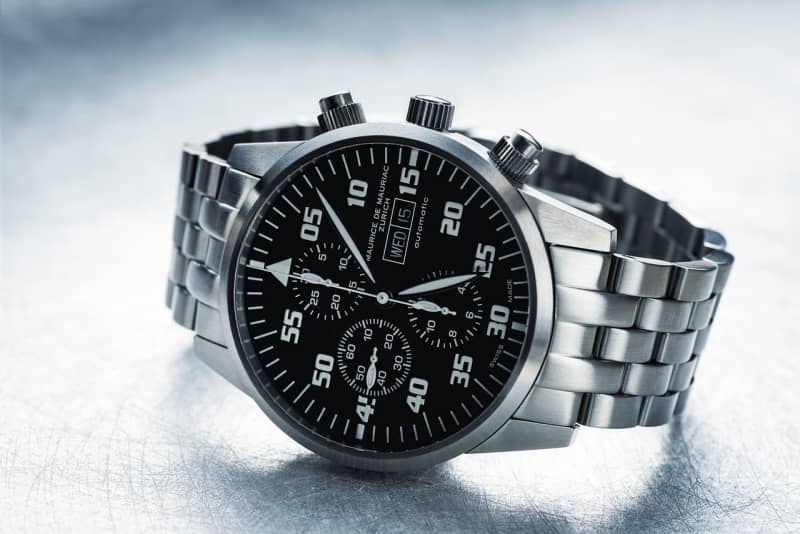Is your automatic watch running too fast? Don’t worry, you’re not alone.
Many watch enthusiasts face this issue. Automatic watches are marvels of engineering, but they can sometimes run fast. This can be due to several reasons, such as magnetization or physical shock. Understanding the cause is the first step to fixing it.
In this guide, we’ll explore the common reasons why your watch may be speeding up and how you can address these issues. Whether you’re a seasoned collector or a new owner, these tips will help you keep your watch accurate and reliable. Let’s dive in and get your watch back on track.

Credit: www.soflypart.com
Identifying The Issue
When your automatic watch starts running fast, it can be frustrating. You rely on your watch to keep accurate time, so any deviation can throw off your entire schedule. Identifying the issue is the first critical step to resolving it. Let’s dive into the signs your watch might be running fast and the common causes behind it.
Signs Your Watch Is Running Fast
One of the most obvious signs is that you notice your watch is ahead of other clocks. This discrepancy can be minor, like a few seconds, or significant, like several minutes each day.
Another sign is if you’re constantly adjusting the time. If you find yourself frequently resetting your watch, it’s a clear indication something is amiss.
You may also notice that specific activities seem to trigger the fast running. For example, after a vigorous workout or exposure to a strong magnetic field. These observations can help you pinpoint potential causes.
Common Causes Of Fast Running Watches
One common cause is magnetization. Automatic watches are susceptible to magnetic fields, which can cause the internal components to speed up. This can happen if you place your watch near electronic devices or magnets.
Another cause could be a mechanical issue. The balance wheel, which regulates timekeeping, might be damaged or malfunctioning. If the balance wheel is off, the entire timekeeping mechanism can be thrown off.
Environmental factors can also play a role. Extreme temperatures, especially heat, can affect the lubrication inside the watch. This can lead to faster movement of the gears.
Lastly, your watch might need a professional service. Over time, wear and tear can affect the accuracy of your watch. Regular maintenance is key to keeping it running smoothly.
Have you noticed any of these signs with your watch? Identifying the issue early can save you a lot of headaches and ensure your timepiece remains reliable.

Credit: www.youtube.com
Initial Troubleshooting Steps
Automatic watches are known for their precision and elegance, but sometimes they can run fast, causing frustration. Before you rush to a professional, there are some initial troubleshooting steps you can take. These steps are easy and can often solve the issue without much hassle.
Checking The Power Reserve
First, check the power reserve of your watch. Automatic watches rely on your movement to stay powered. If your watch hasn’t been worn regularly, it might be running fast due to a low power reserve.
Wind your watch manually to ensure it has enough energy. You can do this by rotating the crown clockwise. Generally, 30 to 40 turns are sufficient.
Once fully wound, wear the watch consistently for a few days. This helps it maintain an adequate power reserve, potentially solving the fast-running issue.
Resetting The Time
Sometimes, simply resetting the time can fix the problem. Pull the crown out to the time-setting position. Adjust the time to the correct hour and minute.
Push the crown back into its normal position. Observe your watch for a day to see if the problem persists.
Resetting the time helps recalibrate the mechanism, which may have been disrupted, causing the watch to run fast.
These initial steps often resolve the issue. But if your watch continues to run fast, it may need professional attention. Don’t hesitate to consult a watchmaker for more complex problems. Have you ever experienced this with your watch? What steps did you take?
Environmental Factors
Automatic watches are delicate instruments. They can be influenced by various environmental factors. These factors can cause them to run fast. Understanding these influences can help you maintain your watch’s accuracy.
Impact Of Temperature
Temperature changes can affect your watch’s speed. Extreme heat can make the components expand. This expansion can cause the watch to run faster. Cold temperatures can have the opposite effect. They can slow down the watch. Aim to keep your watch at a stable temperature. This helps maintain its accuracy.
Effects Of Magnetic Fields
Magnetic fields can disrupt your watch’s movement. These fields can come from everyday items. Phones, speakers, and even some appliances can create magnetic fields. Exposure to these fields can cause your watch to run fast. Keeping your watch away from such items can help. Consider getting it demagnetized if needed. This can restore its proper function.

Credit: www.soflypart.com
Movement Regulation
Movement regulation is essential for keeping an automatic watch precise. If your watch is running fast, regulating its movement can help. This involves fine-tuning the balance wheel and adjusting the regulator. Understanding these components will guide you to fix your watch.
Understanding The Balance Wheel
The balance wheel is the heart of your automatic watch. It controls the watch’s accuracy by oscillating back and forth. Each oscillation helps to measure time precisely. Think of it as a tiny pendulum. When the balance wheel moves correctly, your watch keeps time accurately. But if it speeds up, it can cause the watch to run fast.
Various factors can affect the balance wheel. Temperature changes, magnetic fields, and physical shocks are common issues. Regular maintenance helps keep the balance wheel in good condition.
Adjusting The Regulator
The regulator is a small lever on the movement of the watch. It adjusts the speed of the balance wheel. Moving the regulator slightly can correct the watch’s timing. To slow down a fast-running watch, move the regulator towards the “S” or “-” sign. This shortens the balance wheel’s oscillation.
Make small adjustments and check the timekeeping. It’s essential to be careful and precise. Too much adjustment can make the watch run slow. Regularly check your watch’s accuracy after adjusting.
Using a timegrapher can help in this process. It measures the watch’s accuracy and helps in fine-tuning the regulator. If unsure, seek professional help to avoid damage.
Professional Servicing
Professional servicing is essential for maintaining the accuracy and longevity of your automatic watch. Sometimes, basic troubleshooting may not fix a watch running fast. At such times, expert help becomes necessary. Experienced watchmakers can diagnose and repair issues that are beyond your expertise.
When To Seek Professional Help
If your watch runs fast consistently, it may need professional attention. Regular wear and tear can affect its accuracy. If you notice sudden changes in timekeeping, it’s a clear sign. Also, if you hear unusual noises, seek help. These could indicate internal problems.
Choosing A Reputable Watchmaker
Finding a skilled watchmaker is crucial. Look for certified professionals. They should have good reviews. Word of mouth recommendations are valuable. Check if they specialize in your watch brand. This ensures they know its intricacies. A reputable watchmaker will offer a warranty on their work. This guarantees peace of mind.
Preventive Measures
Keeping your automatic watch running accurately is crucial. Preventive measures help maintain the watch’s precision. Simple steps ensure your timepiece stays in top condition. Here are some effective strategies.
Proper Storage Tips
Store your watch in a cool, dry place. Avoid exposure to extreme temperatures. High heat can damage internal components. Moisture can lead to rust and corrosion. Use a watch box or case for added protection. Keep the watch away from magnets. Magnetic fields can affect the watch’s movement. A dedicated storage space ensures safety and longevity.
Regular Maintenance
Schedule regular check-ups with a professional. A watchmaker can identify issues early. Regular servicing keeps the mechanism clean. Lubrication is essential for smooth operation. Replace worn-out parts promptly to prevent further damage. Clean the watch exterior gently with a soft cloth. Avoid using harsh chemicals or cleaners. Regular maintenance ensures your watch runs accurately.
Diy Fixes
DIY fixes can be a great way to solve issues with your automatic watch running fast. By taking a hands-on approach, you can often correct problems without needing professional help. Let’s explore two effective methods: using a demagnetizer and cleaning the movement.
Using A Demagnetizer
Magnetism can cause your watch to run fast. A demagnetizer can fix this. First, buy a demagnetizer. Place your watch on it. Press the button to start. Move the watch slowly over the device. This process removes magnetic fields. After a few seconds, stop and check your watch. It should run at a normal speed.
Cleaning The Movement
Dirt and dust can affect your watch’s movement. Cleaning can help. First, open the watch back carefully. Use a soft brush to remove dust. You can also use a special cleaning solution. Apply it gently with a cotton swab. Be careful not to damage any parts. After cleaning, reassemble your watch. Check if it runs correctly. Keeping the movement clean ensures accurate timekeeping.
Long-term Care
Long-term care involves regular maintenance of your automatic watch. Adjust the regulator or demagnetize it to fix a fast-running watch. Proper care ensures accurate timekeeping.
Taking good care of your automatic watch ensures it keeps ticking accurately for years to come. Long-term care is more than just a one-time fix; it’s about consistent attention to detail. By adopting a few good habits, you can keep your watch running smoothly.Storing Your Watch Safely
Where you store your watch when you’re not wearing it can make a big difference. Avoid placing it near electronic devices like phones or tablets. These can create magnetic fields that interfere with your watch’s accuracy. Keep your watch in a cool, dry place. Humidity and extreme temperatures can damage the internal mechanisms. Using a watch box or a dedicated drawer can help protect it from dust and accidental knocks. Consider using a watch winder if you have multiple automatic watches. This device keeps your watch moving when not in use, preventing the lubricants inside from settling and causing issues.Scheduling Routine Check-ups
Think of your watch as a small machine that needs regular maintenance. Just like your car, it benefits from routine check-ups to stay in top shape. Schedule a professional service every 3 to 5 years. A watchmaker can clean and lubricate the internal parts, ensuring everything runs smoothly. This can prevent your watch from running fast or developing other issues. Don’t wait for a problem to arise. Regular servicing can catch minor issues before they become major repairs. Does your watch seem off? A quick check-up might save you from future headaches.Frequently Asked Questions
Why Is My Automatic Watch Running Too Fast?
Your automatic watch might run fast due to magnetization, excessive temperature changes, or impact damage. Get it demagnetized or serviced by a professional.
How Do You Slow Down An Automatic Watch?
To slow down an automatic watch, adjust the regulator lever towards the “S” (slower) position. Consult a watchmaker for precise adjustments.
Can A Watch That Runs Fast Be Fixed?
Yes, a fast-running watch can be fixed. A professional watchmaker can adjust the movement. Regular maintenance helps.
What Causes An Automatic Watch To Gain Time?
An automatic watch may gain time due to magnetic exposure, temperature changes, or a need for servicing. Regular maintenance ensures accuracy.
Conclusion
Fixing a fast automatic watch requires patience and care. Adjust the regulator gently. Keep your watch clean and dust-free. Regular servicing by a professional helps maintain accuracy. If problems persist, consult a watchmaker. Understanding your watch’s needs ensures long-lasting performance.
Follow these tips, and enjoy precise timekeeping.
